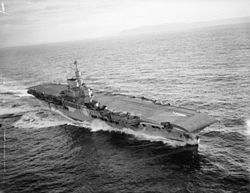
Back Operation Crimson German Opération Crimson French Operasi Crimson ID クリムズン作戦 Japanese Операція «Кримзон» Ukrainian
| Operation Crimson | |||||||
|---|---|---|---|---|---|---|---|
| Part of the Pacific Theatre of the Second World War | |||||||
 HMS Victorious | |||||||
| |||||||
| Belligerents | |||||||
|
|
| ||||||
| Commanders and leaders | |||||||
|
|
| ||||||
| Strength | |||||||
|
2 aircraft carriers 3 battleships 1 battlecruiser 6 cruisers 10 destroyers 2 submarines 34–39 fighters |
Shore defences 2 reconnaissance aircraft 9–10 fighters | ||||||
| Casualties and losses | |||||||
|
Unknown human losses 1 cruiser damaged 2 destroyers damaged 2 fighters destroyed |
Unknown human losses 2 reconnaissance aircraft destroyed 2 fighters destroyed 2 fighters damaged | ||||||
|
Civilian casualties: 1 war correspondent on an Allied ship was killed | |||||||
Operation Crimson was an Allied naval operation in the Second World War of the Eastern Fleet, the objective being simultaneous naval bombardment and aircraft attacks on Japanese airfields in the Indonesian cities of Sabang, Lhoknga and Kutaraja, from aircraft carriers in the Indian Ocean on 25 July 1944.[1]
- ^ Boniface 2006, p. 86.